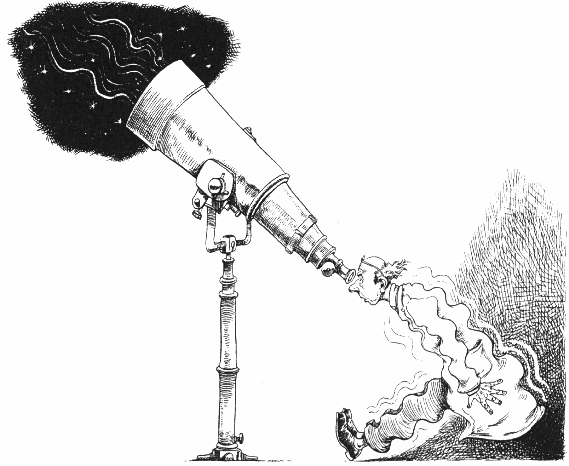

![]()
December 7th 1996
Astronomers are able to look at the sky in many ways that are inaccessible to the eye. But gravity waves should let them see some very strange things indeed.
They are world-shattering events that pass unnoticed; catastrophes that unfold quietly in remote places. Nobody has ever seen, nor is ever likely to see, the wrenching turmoil of two black holes in collision.
Given the nature of black holes--accumulations of matter so dense that not even light can escape from their gravitational fields--this is not surprising. But since such events are invisible, physicists hope for the next best thing: to feel them. Cataclysms such as colliding black holes give off gravitational waves. These are, in effect, ripples in space. And several group of scientists are building a new generation of enormous instruments that might be able to sense these waves. Meanwhile, other groups are spinning computerised stories of such apocalypses, in order to predict what the new machines will see. If all their predictions and calculations are right, gravity waves could eventually join light, radio waves and other sorts of cosmic noise as useful spanners in the tool-kit of astronomy. Einstein's general theory of relativity (the theory of gravity that replaced Newton's) says that space is distorted by anything that has mass. This distortion can be thought as like the way a trampoline is distorted when someone sits on it (though the distortion affects the four dimensions of space and time, rather than the two dimensions that a trampoline surface has). Thus an object moving back and forth warps space back and forth, sending out waves of disturbance. These gravitational waves then travel out at speed of light, distorting the space through which they pass--and anything that space contains--as they go. But waves from even the most violent events are mere shadows of a tremor by the time they reach earth. Not one has managed to tickle any of the various gravity-wave detectors built so far. By 2000, though, a number of more sensitive instruments should be operating. {\sc geo \small 600}, an Anglo-German collaboration located near Hanover, should be the first. virgo, a Franco-Italian project based in Pisa, and ligo, its American counterpart (with instruments in the states of Washington and Louisiana), will follow shortly after.
Each of these ``telescopes" will consist of a pair of tunnels up to 4km (2 .5 miles) long, arranged at right angles to each other. Any gravity wave passing through one of the instruments will alternately stretch and squeeze one tunnel more than the other one. To detect the distortion, laser be ams will be shone down both tunnels, bouncing of mirrors at the ends and being compared when they return. If one tunnel is affected by gravitational wave, its laser beam will travel a different distance and will thus end up slightly out of step with the other beam. A picture of the wave's passage can therefore be built up. The kind of event that these gravity-wave telescopes (known as interferometers) are designed to notice is the coalescence of ``compact binaries"--two lumps of extremely dense matter in orbit around each other. The lumps in question are likely to be either black holes or neutron stars--left-overs from the collapse of stars that have run out of fuel. Astronomers suspect there should be a lot of these bodies about, but they are very hard to see. However, two of then in a decaying orbit, spiralling ever closer towards each other, might be detectable. They will--in the last three or four minutes before they merge--be spinning around each other hundreds of times a second, at a large fraction of the speed of light. When this happens, the space nearby will be whipped into a storm of gravitational waves.

Now listen very carefully
Even this, though, will not be easy to see. If the theorists are right about the frequency of compact binaries, an interferometer would have to be able to detect binary coalescences as far away as the Virgo cluster of galaxies, 50 m light years distant, to pick up a few of them each year. But the waves from binaries that far away would distort things on earth by only {\small 1} part in {\small 10$^21$}. In other words, even if an interferometer were to be built with tunnels several light years long, such waves would alter their lengths by only the thickness of a human hair. The detection of any waves at all, then with tunnels mere hundreds or thousands of metres long, would be an impressive technological feat. It would also be an important piece of science--further confirming Einstein's theory, which has few experimentally detectable differences from that of Newton. And there are grander plans. Researchers hope that patterns in the waves may let them deduce not merely that a merger is taking place, but also the masses and sizes if the coalescing objects. This would mean comparing the observed gravity waves with the predictions of precisely crafted theoretical models. One intriguing calculation, recently published in Physical Review Letters by Stuart Shapiro of the University of Illinois at Urbana-Champaign, is that these models will have to include a peculiar and most un-Newtonian effect called ``gravitomagnetism". Just as an electric current in a wire creates a magnetic field (which is how an electromagnet works), a spinning mass ought, if Einstein was correct, to generate a gravitomagnetic field. This field would, in turn, alter the path of any other mass moving nearby, just as a magnetic field can move a wire carrying an electric current (the principle behind an electric motor). A satellite known as Gravity Probe b, being built at Stanford University, is due to be launched in 1999 to check that the earth's gravitomagnetic field actually exists and is as small as general relativity predicts. But though it is generally so weak that most calculation ignore it, Dr Shapiro reckons that gravitomagnetism will be strong in the case of a pair of neutron stars or black holes that are close together--especially if (as is thought usually to be the case) one or both of them is spinning like a top. Just before they merge, the gravitomagnetic field will be as strong as the regular force of gravity.
Adding gravitomagnetism into the calculations should help extract more meaning from any gravity waves that the detectors do observe. Neutron stars, in particular, though they are just clumps of neutrons, are thought to do odd things because of their enormous densities. As well as behaving like ordinary fluids, they may sometimes be frictionless, ``superfluids". It is even possible, in theory, for one to exist as icosahedral (ie, soccerball-shaped) shell containing a superfluid center. The other reason neutron stars are interesting is that they are thought to be a common by-product of certain sorts of supernovae--stellar explosions, which astronomers also want to know more about. And Nils Andersson of Washington University in St Louis and Kostas Kokkotas of the University of Thessaloniki in Greece, reckon that in the aftermath of a supernova, a single neutron star may wobble hard enough to give out detectable gravitational waves.
A star becomes a supernova when, having run out of fuel, it stops burning and implodes. When its core reaches neutron-star density, the rest of the collapsing material rebounds from it, resulting in a tremendous explosion. However, everything that might carry information from the core--light, x-rays and even neutrinos (ethereal particles that go straight through almost anything)--gets diverted in the fury of the blast. Everything, that is, except for gravity waves. These, because they are distortions in space itself, and do not have to compete with other matter to get through, sail on undisturbed.
Rough calculations by Dr Andersson and Dr Kokkotas show that if 1987a, a supernova seen in a nearby galaxy known as the Large Magellanic Cloud, had turned a millionth if its explosive energy into gravitational waves (which they reckon is quite plausible), such waves would have been strong enought for the new generation of detectors to have picked up. They could thus have been decoded to reveal the core's pulsations. These are two drawbacks. Supernovae as close as 1987a (the Large Magellanic Cloud is a mere 169,000 light years away) are almost as rare as tulips in the Arctic. And even though the waves they emit may be strong, they are probably too high in frequency for beam interferometers to sense. Such waves could, however, be detected by a different sort of gravity telescope--a ``resonant-bar" device. This works by sensing the vibrations in a large, suspended lamp of metal. Several of these devices are now being built to the same sensitivity as geo 600 and its kin. They have a disadvantage, though. Beam interferometers can detect a wide range of gravity waves. Resonant-bar machines must be tuned to a narrow band of frequencies. Unfortunately, precisely which frequencies are good for supernova-watching is not yet known. As a science, gravitational astronomy has promise. But it is still in the age of the crystal-radio set rather than the transistor.
Economist, December 7, 1996